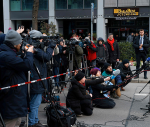You are here
Irish affinity for Palestinians runs deep
May 27,2019 - Last updated at May 27,2019
It is always gratifying to see the strength of Irish solidarity with the people of Palestine. This was brought home again last week during a visit to Ireland. While Eurovision was in Tel Aviv, a coalition of Irish senators, non-governmental groups and entertainers held a counter-concert “Palestine: You’re A Vision” to demonstrate Irish “solidarity with the oppressed Palestinian people living under occupation, under siege or in exile”. And while in Dublin, we met with political leaders preparing for the final parliamentary vote, later this summer, on a bill to ban products originating in illegal Israeli settlements from being sold in Ireland.
The bill, which has broad public and political support, has passed several rounds in the Senate and an early vote in the lower chamber. Should the bill pass the final vote and become law, Ireland will be the first EU country to take a concrete stand against illegal Israeli settlements, just as the Irish were the first in Europe to lead the way against apartheid in South Africa.
This Irish affinity for the injustices visited upon the Palestinian people runs deep in their history and culture. For example, there is documentary evidence that in the 1920’s, Irish Republican movement wrote in one of their manifestos of their solidarity with the Arabs in Palestine, seeing their struggles against the British Empire as one and the same fight as their own. Later, in 1970’s, the Palestine Liberation Organisation (PLO) developed close ties with the Irish Republicans. And, during the 1980’s, the PLO office in Dublin was headed by an Irish national, the only PLO office not run by a Palestinian.
The connections were not just political. For the Irish, it was born of an affinity for victims of colonial oppression, the result of their own history as victims of British colonialism. In Ireland, this history is ever-present. There are reminders of its terrible past around every corner. Whether it is the imposing steeples of the Anglican Church of Ireland, brought by the colonisers and imposed on Irish soil, or the monuments to the famine of the 1840’s, during which over 1 million Irish perished from starvation and another million-and-a-half were forced to emigrate because they were denied the right to eat the abundant product of their own land, which was intended for export to Britain. We saw one particularly touching plaque that hangs in the home of the Lord Mayor of Dublin. It is in honour of the Choctaw Indian Nation of North America, themselves victims of cruel settler colonialism, who collected funds during the Irish famine to aid its victims.
This Irish history with colonial rule goes back centuries. Last Sunday, my wife and I were walking down Lower New Street in Kilkenny, a small city south of Dublin, when we came across the remnants of an ancient tower and the ruins of a high stone wall. On closer examination, we found signage indicating that this was Talbot’s Tower and part of the kilometres of 7.6m-high walls that surrounded the original Anglo-Norman colonial settlement that became Kilkenny. The sign noted that wall had originally been built in the 13th century. One paragraph toward the end of the description of the wall’s history deserves to be quoted in full:
“Whilst the main purpose of the city walls was to protect the colonists living inside from attack, they were also used to collect taxes. People living outside the city walls who wished to sell their goods in the marketplace had to pay a toll as they went through any of the seven city gates. The walls were also a statement of Anglo-Norman power and authority over the native Irish, who were kept under constant surveillance from the nine towers on the city walls, one of which was Talbot’s Tower.”
Not only its insidious purposes, spelled out so clearly on the sign, but the size of the wall and the very look of its ominous tower, are so strikingly similar to the Israeli Wall that “separates” Palestinians, not just from Israeli settlements, but from their own lands.
The Irish from the island’s southern and north-western counties won independence from British rule, and nearly 100 years ago, the Republic of Ireland came into being. But even with independence, they never forgot their history or their ability to demonstrate empathy for others who remain oppressed.
At the end of a recent visit to Kilmainham Gaol, the notorious site where the British imprisoned thousands of Irish who were accused of crimes against the empire, and where they executed the leaders who signed the proclamation of the “Irish Republic”, one of our tour guides made reference to the struggles of the Palestinians and expressed the hope that one day they too would enjoy freedom.
The Irish story is not yet over. The Good Friday Agreement (GFA) created a path forward to peace for the northern counties that remained connected to the British-led United Kingdom. But that agreement is now in danger as a result of Britain’s push to exit the European Union.
One of the by-products of the GFA has been an erasure of the border between Northern Ireland and the Republic of Ireland. Goods and people move freely across the now non-existent borderline. Should Britain leave the EU, north and south may very well be separated once again, causing grave damage to the economies of both. But while the Irish are justifiably preoccupied with the dangers of Brexit, their vision continues to extend beyond their island to encompass not only the Palestinians, but the plight of refugees from other lands desperate to escape poverty. They, too, remind many Irish of their own history and of their many family members who were forced into exile seeking a better life.
Each time I visit Ireland, I marvel at this compassionate island and am humbled by its people and their commitment to justice.
The writer is president of the Washington-based Arab American Institute













